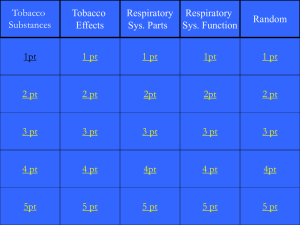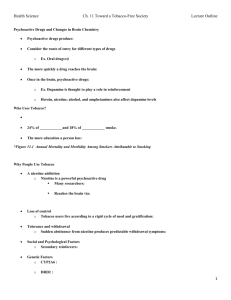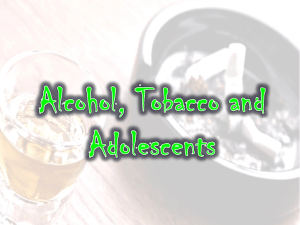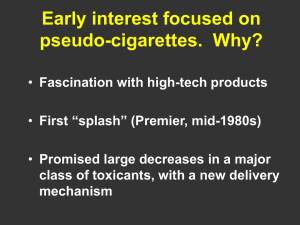Tobacco
advertisement
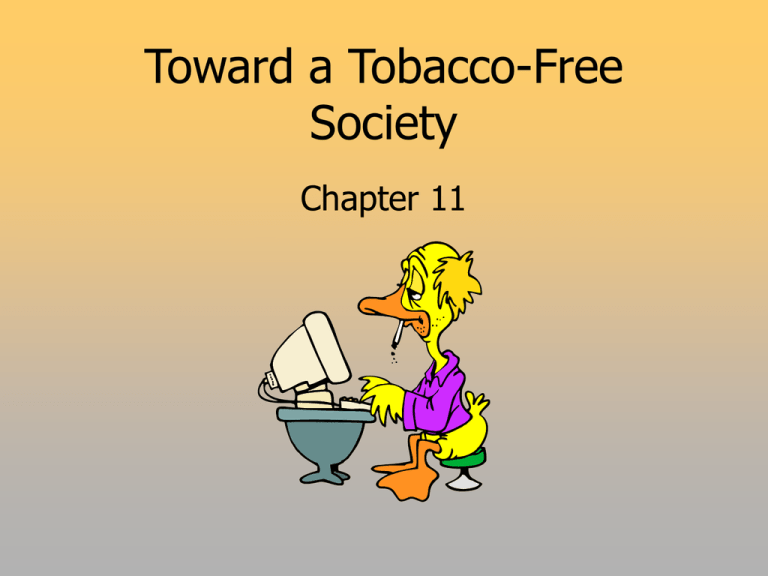
Toward a Tobacco-Free Society Chapter 11 Use of Tobacco Why People use Tobacco Nicotine Powerful psychoactive drug Reaches Brain via bloodstream in seconds Most physically addictive of the psychoactive drugs. 2 3 Loss of Control Three out of four smokers want to quit – 60%-80% kick the habit at a stop-smoking clinic. – However, 75% start smoking within a year. – Relapse rate similar to alcoholics and heroin addicts. 4 Tolerance and Withdrawal Using tobacco develops tolerance – addiction may occur within a couple of days. Abstinence from nicotine: – predictable withdrawal symptoms – Occurs within hours of last dose of nicotine – Most symptoms pass in 2-3 days. 5 Social and Psychological Factors Established habits or cues to trigger smoking Secondary reinforcers. 6 Why Start in the First Place? Decreases in usage in the 1980’s but a steady increase in the 1990’s. Largest increase was 13- and 14-years old. College aged increased from 22% in 1993 to 29% in 1999. Children and teenagers make-up 90% of all new smokers in this country. 7 Listening to Advertising Tobacco spends nearly $6 billion per year. 86% of teens prefer the top three most advertised brands. Joe Camel is more familiar than Mickey Mouse. 8 Who Uses Tobacco? Characteristics which could increase the potential for use. – A parent or sibling uses tobacco – Peers use tobacco – Child comes from blue-collar family – Child comes from low-income home – Single parent. – Performs poorly in school – Child drops out of school – Has positive attitudes towards tobacco 9 10 Immediate Effects Acts on the brain like cocaine and heroin Mild nicotine poisoning Stimulates the cerebral cortex Releases epinephrine, norepinephrine and dopamine Physiological effects on the body 11 12 Health Hazards Unfiltered cigarettes = 5 billion particles per cubic MM 50,000 times more than polluted urban air Carcinogen Damages the lining of the respiratory tract Poisonous substances = arsenic and nicotine Carbon monoxide - 400 times stronger 13 14 15 The Long-Term Effects Cardiovascular Disease Coronary Heart Disease (CHD) atherosclerosis angina pectoris myocardial infarction Lung Cancer and other cancers Chronic Obstructive Lung Disease emphysema Other Respiratory Damage 16 Additional Health, Cosmetic, and Economic Concerns Ulcers Impotence Reproductive health problems Dental diseases Diminished physical senses Injuries Cosmetic concerns Economic costs 17 Cumulative Effects Males:before 15 yrs. old are half as likely to live to 75 versus those who did not smoke Female smokers spend 17% more sick days in bed than nonsmokers Smokers spend one-third more time away from work due to illness 18 Other Forms of Tobacco Spit (Smokeless) Tobacco Cigar and Pipes Clover cigarettes and Bidis 19 20 The Effects of Smoking on the Nonsmoker Environmental Tobacco smoke (ETS) EPA - 1993 - a classed as a Carcinogen 2000 - “known human carcinogen” Mainstream smoke and Sidestream smoke Twice the tar and nicotine Three times the benzo(a)pyrene Three times the ammonia 85% of smoke in a room is second hand 21 ETS Effects Develop cough, headaches, nasal discomfort, and eye irritation Allergies will be exacerbated Causes 3,000 deaths due to lung cancer Contributes to about 60,000 deaths from heart disease Contributes to increased Asthma attacks 22 Infants, Children, and ETS More likely to develop Bronchitis, pneumonia,& respiratory infections More complications from asthma Increased can of SIDS Children inhale three times more pollutants per unit of body weight than adults. 23 Smoking and Pregnancy Estimated 4600 infant deaths in the U.S. Miscarriage, premature birth, low birth weight, long term impairments in growth and intellectual development Possible higher risks of getting cancer 24 Cost of Tobacco Use to Society Health care costs exceed $70 billion per year. Lost productivity from sickness, disability, and premature death makes it closer to $125 Billion per year. 25 What Can Be Done? Local laws State and Federal laws FDA Marketing efforts and restrictions International Action Private sector Individual Action 26 Quitting Since 1964 - 50% of all adults who have smoked have quit. Benefits Options for Quitting 27 28




